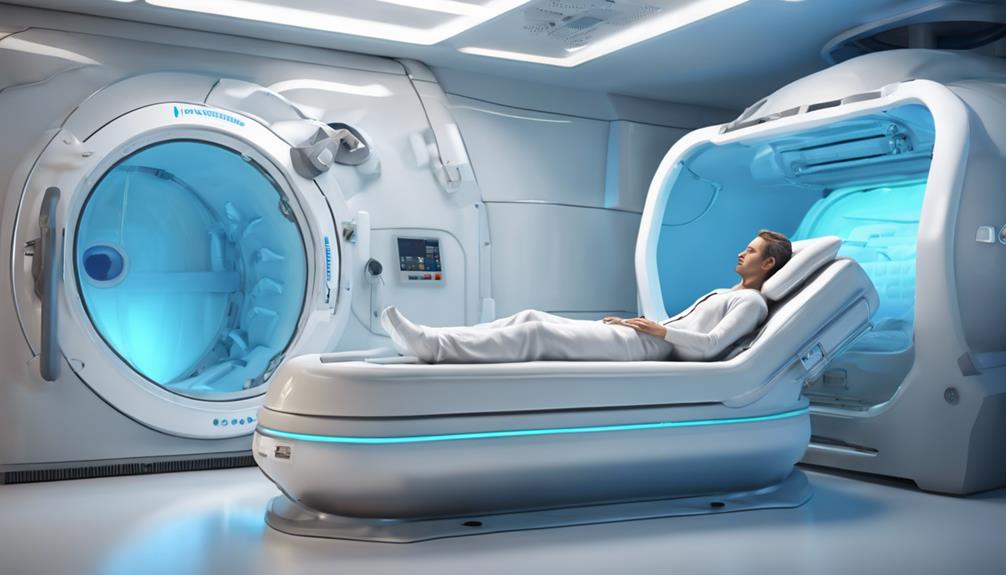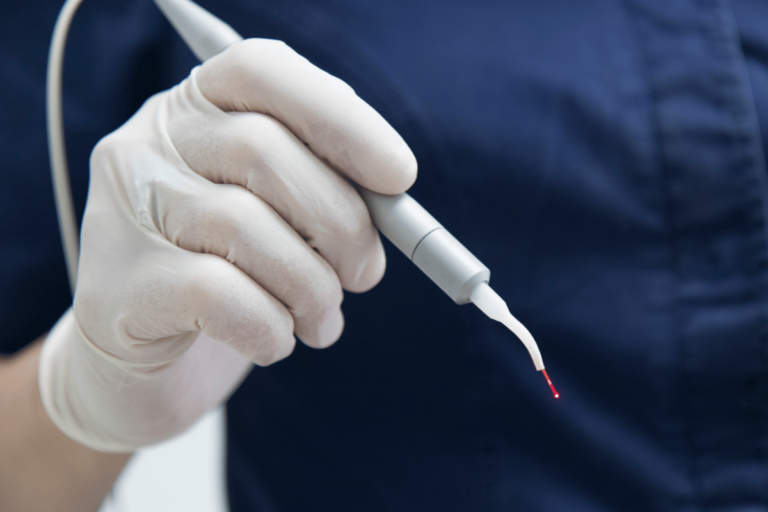Hyperbaric Oxygen Therapy Chambers: Pressurized Healing Environments
If you've ever wondered about the potential of healing within pressurized environments, Hyperbaric Oxygen Therapy Chambers offer a fascinating glimpse into the world of advanced medical treatments. These chambers create a space where the healing power of oxygen is harnessed at elevated levels. The concept behind these chambers goes beyond conventional treatments, opening up possibilities for a range of conditions. As you explore further, you may uncover the intricate ways in which this therapy impacts the body's natural healing processes, hinting at a future where such innovative approaches play a pivotal role in healthcare.
Key Takeaways
- Hyperbaric chambers deliver pressurized oxygen for therapeutic benefits.
- Increased pressure enhances oxygen absorption in the body.
- Healing is promoted through increased oxygen levels in the bloodstream.
- The therapy supports tissue repair and reduces inflammation.
- Safety protocols and training are essential for effective chamber operation.
Understanding Hyperbaric Oxygen Therapy Chambers
To understand hyperbaric oxygen therapy chambers, you must grasp the concept of pressurized environments and how they enhance the delivery of oxygen to the body. Patients undergoing hyperbaric oxygen therapy experience a unique treatment where they breathe pure oxygen in a pressurized chamber. This process allows the lungs to gather more oxygen than would be possible at normal air pressure, leading to higher oxygen levels in the bloodstream. The patient experience can vary from feeling relaxed and comfortable to experiencing mild ear popping or warmth due to the increased pressure inside the chamber.
Research outcomes on hyperbaric oxygen therapy chambers have shown promising results in various medical conditions, including non-healing wounds, decompression sickness, and carbon monoxide poisoning. Studies indicate that the increased oxygen levels promote healing by stimulating the growth of new blood vessels and reducing inflammation. Overall, the patient experience coupled with positive research outcomes highlights the potential benefits of hyperbaric oxygen therapy chambers in the medical field.
Mechanism of Action
Within hyperbaric oxygen therapy chambers, the mechanism of action revolves around the increased pressure facilitating enhanced oxygen delivery to the body's tissues and cells.
As the pressure rises above normal atmospheric levels, the lungs can uptake a notably higher amount of oxygen, which then dissolves into the blood plasma and is transported throughout the body. This increased oxygenation plays a vital role in supporting cellular repair processes.
With higher oxygen levels available, cells can function more efficiently, aiding in the repair of damaged tissues and promoting overall healing. The pressurized environment also helps oxygen reach areas with restricted blood flow, such as wounds or injured tissues, where it can kickstart healing processes that may have been stalled.
Benefits of Hyperbaric Oxygen Therapy
Hyperbaric oxygen therapy offers a variety of benefits that can greatly impact the body's healing processes and improve various medical conditions. The healing benefits of hyperbaric oxygen therapy stem from its ability to increase the amount of oxygen dissolved in the blood, which enhances tissue repair and promotes the growth of new blood vessels. This improved oxygen delivery to tissues helps reduce inflammation, fight infection, and accelerate the healing of wounds.
Oxygen therapy also plays an essential role in supporting the body's immune system by enhancing the ability of white blood cells to kill bacteria and improving the efficiency of antibiotics. Additionally, hyperbaric oxygen therapy can help reduce swelling and alleviate symptoms in conditions such as carbon monoxide poisoning, non-healing wounds, radiation injuries, and certain types of infections.
Conditions Treated With HBOT
When considering the application of Hyperbaric Oxygen Therapy (HBOT) for various medical conditions, it is important to understand the range of ailments that can be effectively treated with this innovative approach. HBOT has shown promising results in treating autism spectrum disorders by helping to reduce inflammation and improve brain function. Additionally, sports injuries, such as muscle strains, ligament injuries, and bone fractures, have benefited from HBOT's ability to accelerate the healing process by increasing oxygen levels in the affected areas.
| Conditions Treated with HBOT | Description |
|---|---|
| Autism Spectrum Disorders | HBOT can aid in reducing inflammation and enhancing brain function in individuals with autism spectrum disorders. |
| Sports Injuries | HBOT accelerates the healing of sports injuries like muscle strains, ligament injuries, and bone fractures by boosting oxygen levels in the injured tissues. |
These conditions highlight the diverse applications of HBOT in medical settings, showcasing its potential to improve outcomes and enhance recovery for patients with varying medical needs.
Safety Considerations
When using hyperbaric oxygen therapy chambers, you must ensure oxygen compatibility checks are conducted meticulously. Regular chamber maintenance protocols are vital to guarantee safe and effective treatments.
Staff training requirements should be met to ensure the proper operation of the chambers and the safety of individuals undergoing treatment.
Oxygen Compatibility Checks
Prior to starting hyperbaric oxygen therapy, it's vital to conduct thorough oxygen compatibility checks to guarantee the safety and efficacy of the treatment. Oxygen compatibility checks are essential to confirm that all components of the hyperbaric chamber, including seals, materials, and equipment, can withstand high oxygen levels without risk of combustion or degradation. Chamber safety relies heavily on these checks to prevent potential hazards such as fires or structural failures.
During oxygen compatibility checks, it's imperative to assess the materials used in the construction of the hyperbaric chamber to confirm they're compatible with high concentrations of oxygen. Components like seals, gaskets, and valves must be specifically designed for use in oxygen-enriched environments to prevent leaks or malfunctions that could compromise the safety of the chamber.
Regular inspections and maintenance of these components are necessary to uphold chamber safety standards and ensure the integrity of the hyperbaric environment. Proper oxygen compatibility checks play a critical role in preventing accidents and maintaining a secure treatment setting for patients undergoing hyperbaric oxygen therapy.
Chamber Maintenance Protocols
Chamber maintenance protocols in hyperbaric oxygen therapy involve regular inspections and upkeep to guarantee safety considerations are met. Considering the critical nature of hyperbaric oxygen therapy environments, adherence to maintenance protocols is paramount to ensure patient safety and the functionality of the chamber.
To achieve this, the following procedures are typically implemented:
- Routine Inspections: Regular inspections of the hyperbaric oxygen therapy chamber are essential to identify any potential issues promptly. These inspections encompass checking the structural integrity of the chamber, ensuring proper functioning of pressure valves, monitoring gas levels, and inspecting seals for any signs of wear or damage.
- Cleaning Procedures: Keeping the chamber clean is vital to prevent contamination and ensure a hygienic environment for patients. Cleaning procedures involve disinfecting all surfaces inside the chamber, including walls, flooring, seating, and control panels. Additionally, air filters and ventilation systems should be regularly cleaned and replaced to maintain air quality within the chamber.
- Maintenance Records: Maintaining detailed records of all maintenance activities, including inspections and cleanings, is essential for tracking the condition of the chamber over time. These records help in scheduling future maintenance tasks and ensuring compliance with safety regulations.
Staff Training Requirements
Ensuring staff are adequately trained in safety protocols is essential for the effective operation of hyperbaric oxygen therapy chambers. Training protocols should adhere to certification standards to guarantee the highest level of safety for both patients and staff. Educational resources play a significant role in equipping staff with the necessary knowledge to handle emergency situations and operate the chamber efficiently. However, theoretical knowledge alone is not sufficient; hands-on practice is equally indispensable in preparing staff for real-world scenarios within the hyperbaric environment. Regular refresher courses and competency assessments are important to make sure that staff maintain their skills and stay updated on the latest safety procedures.
| Training Protocols | Certification Standards |
|---|---|
| Educational Resources | Hands-on Practice |
| Emergency Procedures | Competency Assessments |
| Refresher Courses | Real-world Scenarios |
Future Trends in HBOT Research
You may be interested to know that the future of Hyperbaric Oxygen Therapy (HBOT) research is promising. Emerging applications of HBOT, such as in treating traumatic brain injuries and chronic conditions, are being explored.
Additionally, advancements in HBOT technology, like personalized treatment protocols and improved chamber designs, are shaping the future of this therapy.
Emerging HBOT Applications
Researchers are currently exploring new and innovative applications of Hyperbaric Oxygen Therapy (HBOT) that show promising potential for advancing medical treatment.
- Novel Therapies: HBOT is being investigated in clinical trials for a range of novel therapies, such as treating traumatic brain injuries. Studies are looking into the efficacy of HBOT in reducing inflammation, promoting tissue repair, and improving cognitive function in patients with brain injuries.
- Wound Healing: Another area of interest is the use of HBOT for non-healing wounds, such as diabetic ulcers. Clinical trials are underway to evaluate the ability of HBOT to enhance wound healing by increasing oxygen levels in tissues, stimulating collagen production, and fighting infection.
- Neurological Disorders: HBOT is also being studied for its potential in treating neurological disorders like autism spectrum disorder (ASD). Research is investigating whether HBOT can help improve behavioral symptoms and cognitive function in individuals with ASD, offering hope for new therapeutic avenues in this field.
Technological Advancements in HBOT
Advancements in Hyperbaric Oxygen Therapy (HBOT) technology are shaping the future of medical research and treatment. Pressurized technology and healing innovations are at the forefront of HBOT research. Let's explore the key technological advancements influencing the field:
| Advancement | Description | Impact |
|---|---|---|
| Portable Chambers | Smaller, more portable HBOT chambers allow for increased accessibility and convenience in various settings. | Facilitates treatment in remote locations. |
| Advanced Monitoring Systems | Integration of sophisticated monitoring systems enhances safety and precision during HBOT sessions. | Enables real-time tracking of patient responses. |
| Hyperbaric Simulations | Virtual reality simulations provide training opportunities for medical professionals in HBOT protocols. | Improves knowledge and skills without real-world risks. |
These advancements reflect a shift towards more efficient, accessible, and technologically-driven HBOT practices. As research progresses, the integration of pressurized technology and healing innovations promises a future where HBOT continues to evolve as a valuable therapeutic option.
Conclusion
As you emerge from the hyperbaric oxygen therapy chamber, imagine yourself as a seed bursting forth from the soil, revitalized and ready to grow.
Just as the pressurized oxygen nourishes your body on a cellular level, so too does it nourish your spirit, promoting healing and strength.
Embrace the power of these healing environments, for within them lies the potential for profound transformation and renewal.







